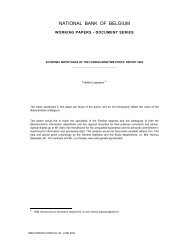Working Paper Research - Nationale Bank van België
Working Paper Research - Nationale Bank van België
Working Paper Research - Nationale Bank van België
You also want an ePaper? Increase the reach of your titles
YUMPU automatically turns print PDFs into web optimized ePapers that Google loves.
1970s, credit demand was stimulated, leading to a period of over-expansion. The return to positivereal interest rates in 1979 placed a "crippling" burden on many debtors. The ensuing debt crisisthreatened the world financial system. Lamfalussy concludes: "Innovation allowed banks totransform margin risk into capital risk which, in this case, was probably a greater threat to thestability of the international banking system - not to mention its rather disastrous effects on theborrowers themselves" (Lamfalussy, 1986b, p. 14).An important concern for Lamfalussy was that, with financial innovations, the transparency of thefinancial system was waning. "The proliferation of different types of assets and liabilities, both onand off banks' balance sheets, clearly obscures their activities - for the banks' own management,for bank supervisors and for the market" (Lamfalussy, 1986b, p. 14). This also had seriousconsequences for the statistics which the BIS had been constructing, as did the gradual merging ofthe Euro-bond market with international bank lending, "progressively eroding the usefulness oftraditionally defined international banking statistics and removing the little transparency which wehave managed to create in this particular field" (Lamfalussy, 1985a, p. 411).Lamfalussy was concerned that the ad<strong>van</strong>tages of financial innovation had been overstated. Anexample was securitisation. In his view, securitisation had attracted quality borrowers to thefinancial markets, by the prospect of borrowing more cheaply than through the banks. Problemdebtors, however, who were unable to tap the financial markets, would continue to take bankcredits (and their liabilities would remain on banks' balance sheets in a non-negotiable form) 62 .Moreover, securitisation might make the managing of an international credit crisis more difficult:"Past experience is not reassuring in this respect. In the 1930s, the large share of international debtin the form of bonds prevented the kind of restructuring of debts that has taken place with banklending in recent years" (Lamfalussy, 1986b, p. 15).Over the next few years, Lamfalussy further elaborated and articulated his basic vision. He wasconcerned about the basic fragility of the financial system, especially banking. He stressed that theSchumpeterian process of creative destruction might entail serious risks for the banking sector. "If,like me, you cannot accept the view that the risk of systemic runs on banks is now a thing of thepast, you feel that such destruction can be more dangerous in banking than in any other sector ofthe economy" (Lamfalussy, 1988, p. 137). Furthermore, he would always pay attention to theinternational dimension, as "the worldwide integration of banking has given this risk a dimensionthat it never had before". He would further stress that the interaction of global imbalances and amore competitive and innovative financial system was apt to lead to increases in debt ratios,"carrying obvious risks in the event of a cyclical downturn" (Lamfalussy, 1988).5.4 BIS work on strengthening the financial systemIn his different functions at the BIS, Lamfalussy also played a major role in the <strong>Bank</strong>'s efforts atstrengthening the international financial system. At the heart of this work was Lamfalussy's vision62 Naturally, the securitisation process went much further than anticipated here by Lamfalussy, also including,for instance, subprime mortgages.21
















